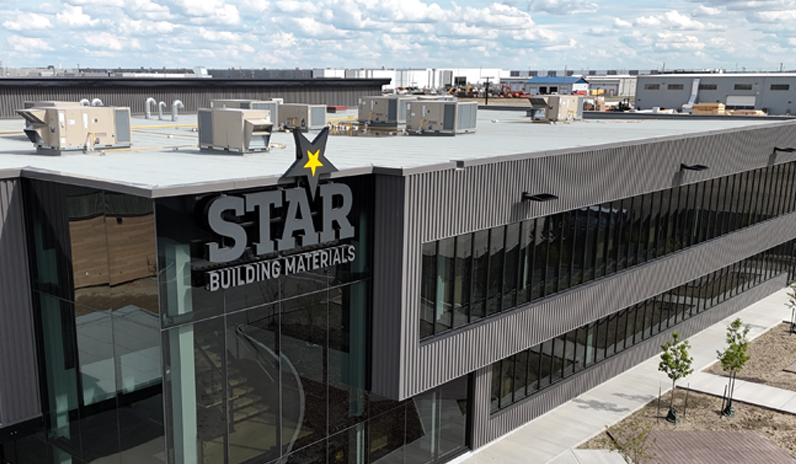Star Building Materials’ New Calgary Facility Champions Sustainable Construction
This story is part of a three-part series on Star Building Materials’ new manufacturing facility expansion in Calgary. Stay tuned for two more articles this summer focusing on how the new headquarters is designed with employees in mind, and how the additional production capacity at the new facility will help build more homes faster in Calgary’s housing market.
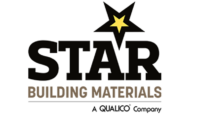 Calgary, AB – Star Building Materials Calgary welcomed nearly 300 staff to its new manufacturing facilities and office space on May 12, marking an exciting new chapter for one of Western Canada’s largest building material suppliers and setting a new standard for innovation and sustainability in Canada’s building materials industry.
Calgary, AB – Star Building Materials Calgary welcomed nearly 300 staff to its new manufacturing facilities and office space on May 12, marking an exciting new chapter for one of Western Canada’s largest building material suppliers and setting a new standard for innovation and sustainability in Canada’s building materials industry.
The 153,000 sq. ft. expansion at Star’s existing distribution centre near Balzac—an industrial hub on Calgary’s northeast edge—brings together a striking new head office and three expansive, open-span production facilities. These buildings support the integrated manufacturing of trusses, engineered wood floors, prefabricated wall panels, and interior finishes, all within a unified 31-acre campus.
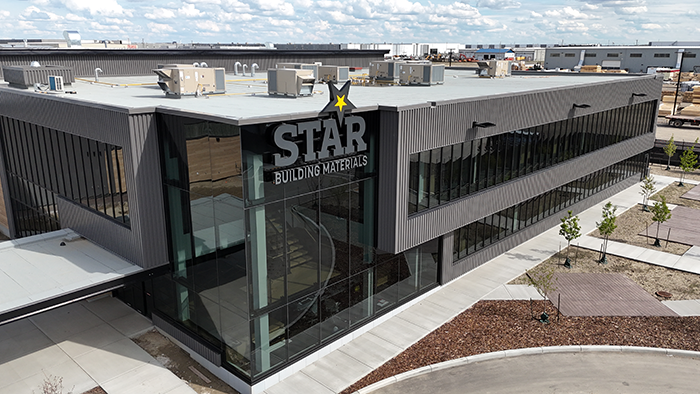
Star’s new Calgary office is one of four new buildings at the site
Ken Crockett, Vice-President, Star Building Materials Calgary, believes the new manufacturing facility will help set a new benchmark for the building materials industry in Alberta and beyond.
“There isn’t really anything else like this in North America,” said Ken, referring to the facility’s uniquely consolidated layout and streamlined workflow, enhanced by the latest technology upgrades.
“It’s going to allow us to significantly scale up our production capacity to better serve our homebuilding partners and support the Calgary home construction market now and into the future.”
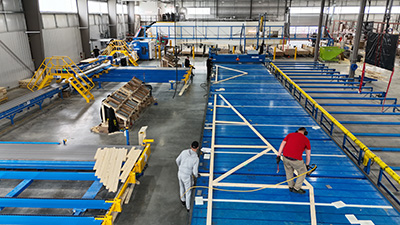 Each building at the site supports a carefully planned workflow, moving raw wood products into finished building components that are delivered directly to construction sites around the city.
Each building at the site supports a carefully planned workflow, moving raw wood products into finished building components that are delivered directly to construction sites around the city.
The goal is to support Star’s ongoing growth by streamlining and optimizing manufacturing processes to better serve homebuilding construction sites across the city—while doing so in a more environmentally responsible way.
Sustainability Meets Efficiency
Every production element, from prefabricated wall panels to trusses and floor systems, flow through their own set of computerized equipment that automates cutting and manufacturing building components used in the construction of new homes throughout the region.
“The new equipment makes us so much more efficient,” explained David Klassen, Director of Manufacturing.
“It not only helps us serve our customers better, but also reduces manufacturing costs and saves material from ending up in the landfill.”
Star Building Materials Calgary installed the first Boise SawTek I-Joist saw in Canada when the distribution yard opened in 2019. For this expansion, Star worked with Boise to design a next generation machine that could more efficiently cut joist packages. This marks the second saw in Canada with Edmonton installing the third this fall. The saw uses sophisticated software and computerized hardware to automatically feed material, measure and cut multiple home packages at a time, optimize inventory and make the best use out of every bundle of I-Joists with minimal waste.
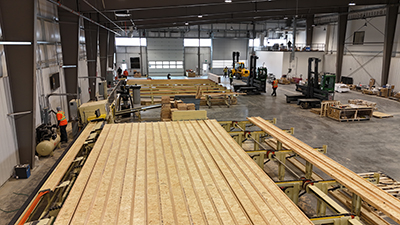 Richard Tunnicliffe, Director, Branch Operations, explains that the saw’s computer-guided measurement systems will also reduce costly errors.
Richard Tunnicliffe, Director, Branch Operations, explains that the saw’s computer-guided measurement systems will also reduce costly errors.
“Where before we would chainsaw cut to the nearest foot, we now saw cut with one sixteenth of an inch accuracy. So, we’re going to get the right cut, the first time.”
As the wood is cut, it is ink jet labeled according to the project specifications, providing construction crews with clear instructions and allowing crews to assemble the joists on site without any guesswork.
At the Truss Plant, an automated system called the MatchPoint® DirectDrive™ system modernizes material handling. It starts with the Ranger® lumber retrieval system which robotically moves the lumber to the MatchPoint®BLADE™ saw, freeing up employees to focus on more productive tasks.
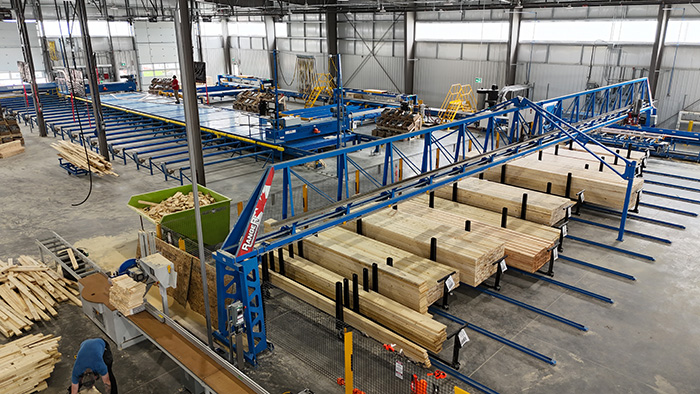
The BLADE™ saw cuts the truss components to length and prints the member information through sophisticated material optimization software. Once cut, the components are sent by conveyor belts directly to the truss assembly stations. All this happens autonomously with only a single operator monitoring the entire system for faults due to lumber defects.
The vast prefabricated wall plant incorporates computerized saws and nailing machines. David explains that the most sustainable feature of the plant is what you don’t see. “The design process intentionally eliminates material from the wall system. By optimizing stud locations and intersection configurations, we reduce the amount of wood used. This in turn reduces thermal bridging which saves the homeowner on energy needed to heat and cool the home,” said David.
Thanks to automated processes and technological innovation, Star Building Materials Calgary is poised to more than double its production capacity, helping meet the demands of a housing market hankering for new homes.
Conserving Energy
Aside from the manufacturing technology, the new buildings at the campus were designed with a focus on another kind of efficiency as well: energy efficiency.
The focus on efficient processes and systems also means the facility will consume less fuel.
“Given how the material flows through the building and ultimately to the construction site, there’s a much shorter travel path, less production time, and less energy consumed through the process,” continued David.
David added that by consolidating all of Star Calgary’s operations on one site, further energy efficiency gains are achieved by eliminating transfers of material between locations. “We are now able to place the source material next to the plant and reduce the amount of fuel used to handle it,” he said.
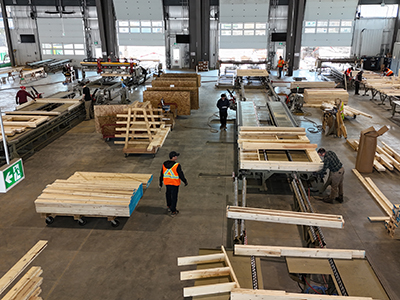 This commitment to efficiency and energy performance extends to the buildings themselves. They are fitted with more efficient dust collection systems, higher R-value building envelopes, and oriented to bring in as much natural light as possible. Where additional light is needed, an LED lighting system consumes far less energy than traditional lighting.
This commitment to efficiency and energy performance extends to the buildings themselves. They are fitted with more efficient dust collection systems, higher R-value building envelopes, and oriented to bring in as much natural light as possible. Where additional light is needed, an LED lighting system consumes far less energy than traditional lighting.
To conserve paper in an industry that churns through vast amounts of it, traditional printed assembly drawings are being eliminated in favour of 75-inch TV screens displaying manufacturing instructions in real time.
Looking to the Future
Star’s newly expanded and consolidated production facility is not only setting a new standard for future large-scale production in North America but also charting a course toward a more sustainable Canadian homebuilding industry.
“We want people to come through the site and get the feeling this is not just another lumber yard,” said Ken.
“We’ve been very intentional in creating a space that raises the bar of professionalism so that our employees feel that they belong to a company that is innovative and forward thinking. It is a place where they can start or build a great career from and make a positive impact.”
Published: February 2025
Published: February 2024
Published: February 2023
Published: January 2024
Published: June 2021
Published: February 2025
Published: February 2024
Published: February 2023
Published: January 2024
Published: June 2021


